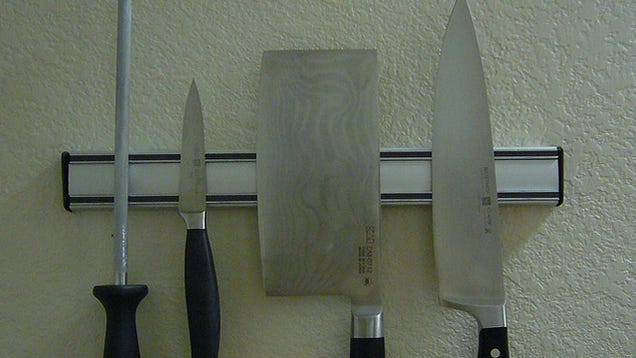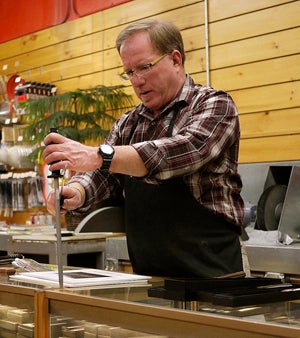
A dull knife is a cook's worst enemy, and easily the most dangerous tool you can have in your kitchen. Thankfully, keeping your knives in good condition to use isn't terribly difficult, and you probably already have the tools required to do it.
Honing or sharpening a knife is not a science. You'll find different people do it in different ways, all of which can get the job done. Still, there is an easy and repeatable way to go about it that doesn't involve potentially cutting yourself. Here's how. Photo by Kent Wang.
Honing vs. Sharpening
The first thing to clear up is the difference between honing a kitchen knife and sharpening one. When most people at home use a "honing steel" or "butcher's steel," or that long metal rod that comes in the center of a knife block, to "sharpen" their knives, what they're really doing is honing them.The difference is that a honing steel straightens out the blade of a knife, making the edge straight and ready to use. As you use a knife, the tip of the blade will eventually bend and curl so you don't get a real blade-on cut at the very tip. The best you can really do at home is to hone your knives regularly to keep the cutting edge straight – for most at-home cooks, this makes the knives "feel" sharper. Check out this video at Chow for a visual description.
Actual knife sharpening is something you'll probably want to have professionally done, but more on that later. First, let's look at how you can keep your knives well honed.

The Tools
The most common knife honing tool is a honing steel, or a butcher's steel. They're ideal for regular, per-use maintenance, and for bringing your knives back into alignment so they cut cleanly with each use. Most knife sets come with them, and most department stores sell them, and since they're so common, we'll focus on those.Honing steels aren't the only things you can use to keep your knives in working order. You could always buy a sharpening stone or water stone, which is usually a flat, rectangular stone that can come in coarse or fine grades depending on the type of knife you want to hone and how sharp you'd like it. You can also buy honing kits, which usually come with multiple sharpening stones of different grades. While we focus on honing steels, the same tips apply to sharpening stones as well.
As for manual or automatic knife sharpeners you can buy from department stores? They vary highly in quality by price and manufacturer, and they're no real substitute for doing it yourself with a honing steel that you probably already have. Plus, some low-end sharpeners can do more damage to your knives than good. We suggest you avoid them altogether, save some cash, and do it yourself. Photo by John Herschell.
Set The Angle
Don't go waving your honing steel and knife around in the air like a television chef. Anchor your honing steel with a towel or dishcloth on the countertop, and hold the steel vertically with the point down into the towel. Then hold your knife perpendicular (at a 90-degree angle) to the center of the honing steel.
Now tilt the knife halfway between perpendicular and parallel to the steel. That should put your blade at a 45-degree angle. Tilt the handle halfway again between 45-degree and parallel to the steel. This should put your knife about 22-degrees from the honing steel. The angle is important because most western knives are molded with a blade that's 20 degrees off of vertical on either side. Practice holding your knife at this angle so you're familiar with how it feels.
If you're using a sharpening stone, the rule still applies: the angle is important, even though the sharpening method will differ.
Hone The Edge
Once you have the angle down, it's time to hone your knife. Move the knife forward to the heel of the knife is just touching the honing steel. Keeping the knife at a 22-degree angle, pull the knife back towards you, all the way across the blade until you pass the tip. Move the knife to the other side of the steel, and repeat the process on the other side of the knife.
Do this four or five times (as long as your knife isn't way out of alignment) and your blade should be ready for use. It's a good idea to do this each time you're about to use one of your knives to keep the blade in alignment and to make sure its safe to use.

When Honing Isn't Enough
Honing your knives regularly is important, but then a knife's blade actually dulls or starts to chip, as opposed to slipping out of alignment, there's little you can do to bring it back. Granted, with proper care, some people can get by the entire life of their knives using a honing steel and taking good care of their blades.
Still, if your favorite knife just isn't what it used to be and you hone it regularly, its time to take it to a professional knife sharpener. It's a good idea to have your knives professionally sharpened regularly – maybe once a year for your most-often used blades. Professional sharpening services can run anywhere between $10 to $25 per knife, depending on length and type. Compared to the cost of new knives, it's a bargain.
Finding a professional sharpener isn't too difficult. If you have a local butcher or farmers market in your area that sells meat and poultry, odds are there's someone there willing to re-edge your knives for a small fee. Alternatively, you can check out this Wall Street Journal articlethat lists a number of sharpening-by-mail services. Just send your knives away, and in a few days or weeks, they come back to you with fresh edges. Photo by Matt Feifarek.
A Final Note
Honing knives is a skill most people who spend any time in the kitchen should know, but when it comes to sharpening knives, or learning to professionally sharpen them, there's no single right way to do it, no magic technique. Many professional sharpeners study under someone else for years before taking up the skill themselves.Exercise caution always when honing your knives, and especially if you want to learn to sharpen them and apply a new edge. There's nothing like using a knife that's been freshly sharpened. However, proper maintenance and honing can make your favorite kitchen knife last for years.
via : Lifehacker

Blogger Comment
Facebook Comment